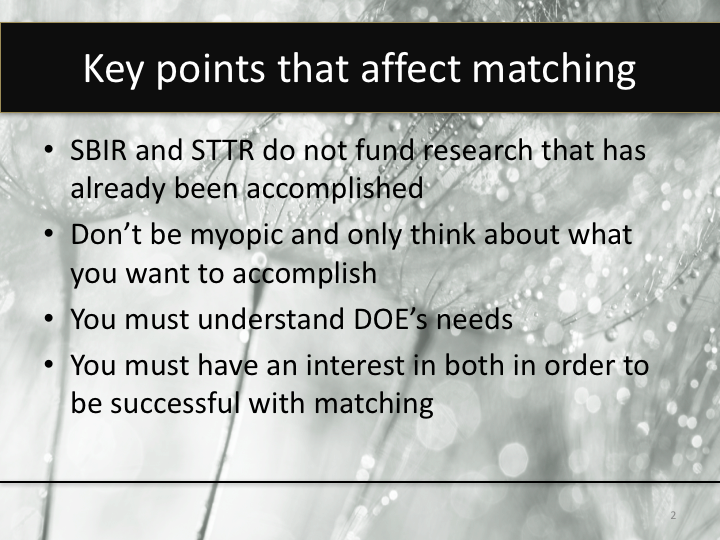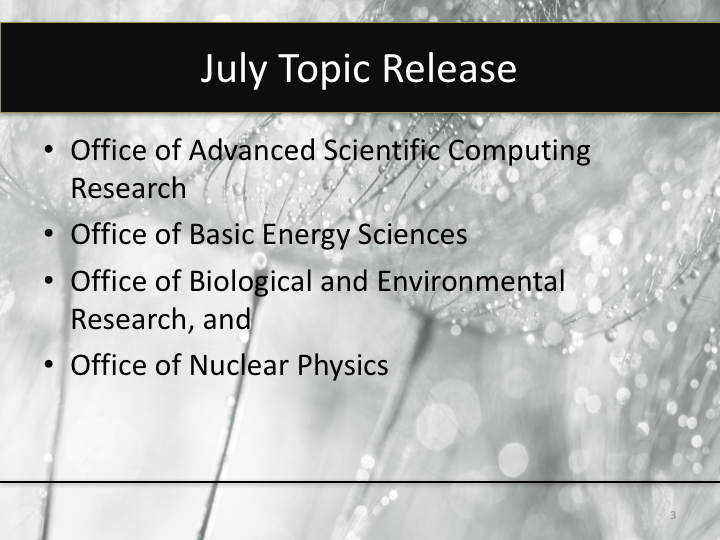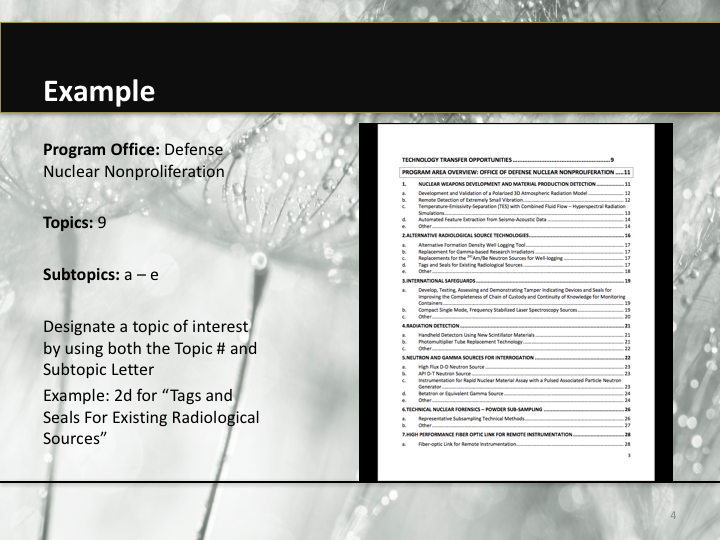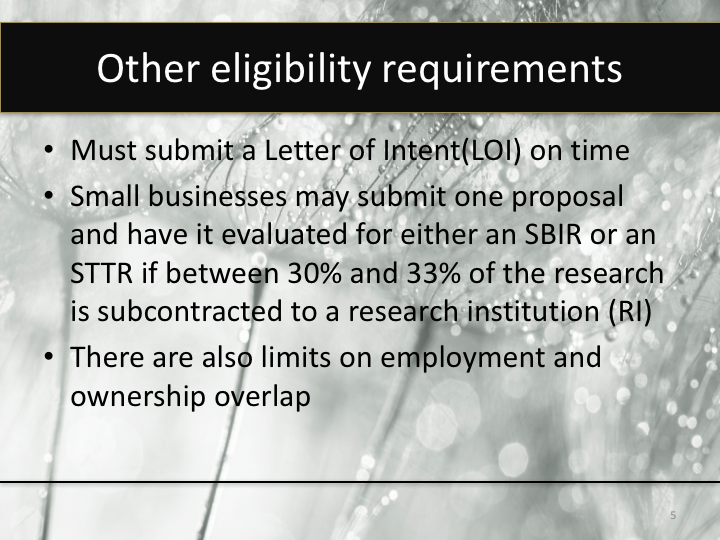Tutorial 2:
How do you find the right topic?
Looking for the right topic requires two things: (1) an understanding of your core competencies; and (2) an understanding of where the Department of Energy’s topics come from. As an aside, the Department of Energy is referred to as the DOE and we will use that acronym throughout. Looking for the right topic is a matching task – one in which you assess if your core competencies can help the DOE address its needs. However, before exploring if there is a match – there are a few fundamental points that you must understand.
- The Small Business Innovation Research (SBIR) and the Small Business Technology Transfer (STTR) programs do NOT fund research that has already been accomplished. In other words, if you have already developed a product and are looking to fund a demonstration – this is NOT the appropriate venue.
- Another point to keep in mind is that if you are myopic and ONLY have an interest in securing funding for a research initiative that you have already mapped out – this is also NOT the right avenue. To be successful in utilizing the SBIR or STTR programs, you must be willing to examine and understand what the DOE needs and then determine if there is a match between its needs and your core competencies. Without an interest in both, you cannot be successful.
When talking about “your” core competencies – we are referring to specialized skills that either you or your company have that will enable you to implement a research and development plan in response to a DOE topic. One assumption that you should make is that to be successful in the SBIR and STTR programs, the proposing team must have research skills acquired either through formal training or through experience.
Let’s begin to explore the DOE’s topics. The DOE releases topics twice a year, once in July, and again in November. The first topic release is provided by four participating DOE Research Programs:
- Office of Advanced Scientific Computing Research
- Office of Basic Energy Sciences
- Office of Biological and Environmental Research
- Office of Nuclear Physics
The second topic release is in November. It is usually larger than the first release and contains topics from a different and larger set of DOE Research Programs. They are listed here so that you can see the diversity of research programs that usually participate in the second release.
- Office of Cybersecurity, Energy Security, and Emergency Response
- Office of Defense Nuclear Nonproliferation
- Office of Electricity
- Office of Energy Efficiency and Renewable Energy
- Office of Environmental Management
- Office of Fossil Energy
- Office of Fusion Energy Sciences
- Office of High Energy Physics
- Office of Nuclear Energy
Understanding that the topics are different in the two releases, you will want to review either the first or second topic release depending upon your research interests. Each topic release is structured in the same way. This is most easily understood by taking a look at the table of contents within the Topics document itself. The table of contents is organized alphabetically by the DOE research program’s name. Underneath each DOE office is a list of topics in bold, with a series of subtopics in regular type font underneath. By scanning the table of contents, you can quickly get a feeling for the type of research that DOE funds and begin to assess if these research areas match with your core competencies.
You don’t have to wait until new topics are released in order to understand the types of research that DOE funds – as previous topic documents can always be found on the DOE SBIR program office website. However, please keep in mind that both closed and open topic releases are found on this same site. Although it is useful to look at the topics at any time in order to develop an appreciation for the types of research that the DOE funds, before deciding which topics you may respond to, it is important to assure that you are only looking at the topics associated with a current Release.
http://science.energy.gov/sbir/funding-opportunities/
Let’s examine where the DOE topics come from. DOE’s mission is to “Ensure America’s security and prosperity by addressing its energy, environmental, and nuclear challenges through transformative science and technology solutions.” Each year, the DOE prepares and submits a budget to Congress to fund initiatives consistent with its mission. Part of the budget is for research and development conducted by numerous entities including federal laboratories, universities, large industrial firms, and small business. Each of the Offices mentioned in the topics document is responsible for fulfilling part of DOE’s overall mission as it relates to their area of expertise. SBIR and STTR topics are in essence an extension of the method that DOE uses to fulfill its research mission. When you respond to a DOE SBIR or STTR topic, you are addressing a national need.
Let’s now return to the question of matching. To do this you must start by being reflective and identifying your core competencies. Let’s assume that you are a materials engineer just starting a new company. You have an interest in high temperature materials and new manufacturing processes. How would you go about finding a good topic? Perhaps the best way to start is by reading the table of contents and using the hyperlinks to jump to those sections that look interesting. As you find good topics, highlight those of interest so you can easily find them again. Another way to ferret out potential topics is to conduct a key word search using relevant terms such as “high temperature”, or “manufacturing”. If you find that you don’t get many hits using this strategy, then expand your search terms.
As you find topics and subtopics that look interesting, consider if you and/or your team have the skill set that could address the problems identified in the topics of interest.
Quiz: Tutorial 2: How do you find the right topic?
-
1
Which of the following statements is false?
-
Nice Work
-
Try Again
-
2
You are always eligible to submit an application to any FOA that you find listed on the DOE or DOE SBIR/STTR website?
-
Nice Work
-
Try Again
-
3
Which of the following is a true statement?
-
Nice Work
-
Try Again
-
4
When searching for a good topic in the DOE SBIR/STTR Topic document, you should:
-
Nice Work
-
Try Again




